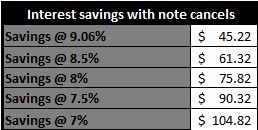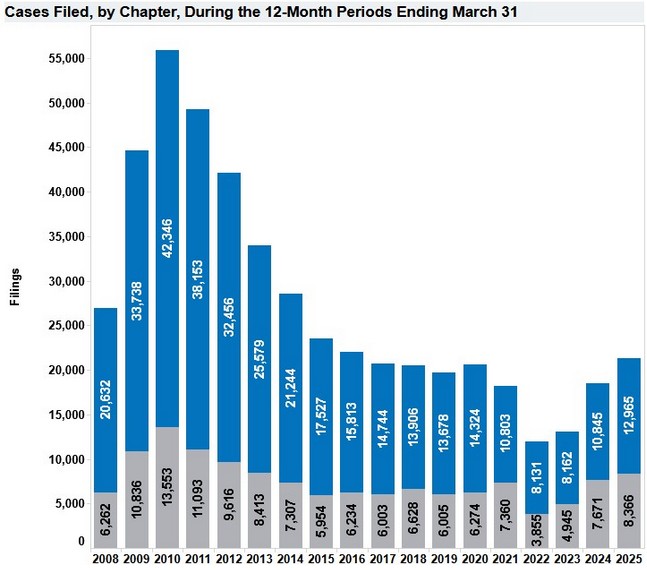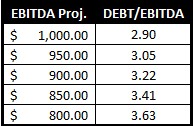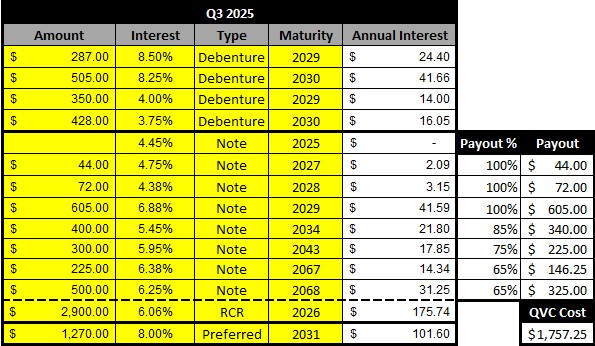Hello 60!
Long reply but hey, what good is a stock forum if we're not going to write about them? This one is fun to analyze too as there is a lot to consider to keeps ones mind sharp. Plus we have had some back and forth and felt it was good to consolidate all my thoughts into one big 'ol post in case anyone new jumps in.
<< Other than the interest accruing at a capped 11% AND possibly naming 2 seats on the Board What is the downside??>>
Well, the downside is as TJ wrote that the board/holders just votes to cancel QVCGP altogether. I am less sure this happens as I wrote before, because if they were going to go that route well they would have already. I see no need to vote and halt the dividend only to later vote again to cancel them outright. We must then ask why they went this route to start? Perhaps bargaining chip in bankruptcy is what comes to my mind as who are major owners of QVCGP?
In my view the company will file bankruptcy and there will not be enough value to upstream to cover either QVCGP, QVCGB, or QVCGA. We must remind ourselves what is the capital structure of QVC Group and then where is the value? The value is all the way at the bottom with QVC, Inc as the OpCo where the majority cash flow comes from but where there is also currently $5,046M in senior secured liabilities and declining earnings potential (EBITDA) and thus cash flows.
Senior holders have an opportunity to be greedy here, as they usually are in distress, and will try and value the QVC, Inc (OpCo) low enough so there's not enough value to upstream. These holders have QVC, Inc equity as collateral against the bonds which means they control the real value and not where everyone keeps looking which is two layers up at QVCGA/QVCGP. The fear of only board seats is not deep enough as reality is QVCGP just goes to $0 because no value to cover.
Liberty Interactive then owns 100% of QVC, Inc equity and they themselves have $1,570M principal value of unsecured debentures to tackle but they don't generate any value as their cash comes from QVC, Inc+ 38% ownership of CBI. What may happen here is senior holders will throw a bone to Liberty Interactive and give them equity warrants or straight equity in QVC, Inc but likely their ownership is diluted to a 5% holding or less or they can't get anything.
Last year QVC, Inc upstreamed $108M in dividends to parent which now could potentially stay home in new org. Even with a stub holding Liberty/QVC Group doesn't get that cash needed anymore.
At the top we now have QVC Group which owns Liberty Interactive and 62% of CBI and where $1,272M of QVCGP sits. It's possible equity ownership of CBI + preferred shares are now leveraged as bargaining tools to get new equity in QVC, Inc but that's where the lawyers fight it out. Now we ask ourselves, with a $800-900M EBITDA is there enough value to upstream to cover QVCGP? I would say no as I previously modeled. QVCGP does sit above QVCGA so if there is anything they come before QVCGA. There is certainly no value to cover QVCGA as it stands. If Liberty only gets a 5% ownership stake in QVC, Inc that means QVC Group would own a holding company that owns 5% of an asset. Like a star that collapses inside to form a black hole, this would create a financial one as QVCGA/QVCGP is effectively worthless.
Let's go back to QVC, Inc though and just play around with TJ's friendly LME idea. They now have $2,900M drawn on bank credit and it currently has an interest of 6.06%. If we look at some the debt being refinanced by other companies with debt ratings similar to QVC, Inc the interest is not too attractive. I find it hard to see QVC, Inc not refinancing the new revolver at around ~9.06% as I mapped out or possibly higher. Revolver interest will go from $2,900M @ 6.06% = 175.74M annual to $2,900M @ 9.06% = $262.60M annual. Taking total QVC, Inc interest from $307.82M to $394.67M. If they took out all the senior secured bonds they have $262.60M in revolver interest which saves the company what $45.22M annually at a 9.06% credit facility? My model on savings depending on where revolver rate goes and assuming all senior notes are gone:

Revolver interest would have to stay at 6.06% to realize the full $132.08M savings and I just find this unlikely given what I am seeing elsewhere and trajectory of the organization. In 2019 that facility had a 3.1% interest rate and after the last refinance it's been in 5-7% range. There is also a risk the banks will want a smaller facility because Zulily and Cornerstone are not borrowers and no reason QxH needs this size so I see this being a reason we see a refinanced facility and not some use of rules 2.19 or 2.20 as TJ suggested in a comment on that Substack. Being this freidnly and loose is just not how banks work even if there are loopholes - good luck convincing the banks to just let you keep drawing on their dime with no clear plan on how to turn the business as the first plan, ATHENs, is not sticking.
Now the higher rate is more likely even if they get the LME as the banks now carry all the risk with $2,900M drawn and company is in theory freed up. Even issuing new notes with their current debt rating will carry a higher rate so new issuance to smooth revolver out won't likely save expense. It comes back to secular decline driving lower EBITDA. And there is a real rise in corporate bankruptcies taking place which all bake into my thoughts a lower rate than 9% is unlikely. We must also note that there are some research that shows companies end up filing even a few years after an LME; banks still have the risk and will need to be compensated for it.

Grey = chapter 11 and blue chapter 7.
Even after this, if EBITDA keeps moving down the reduced leverage can still tighten them with only $2,900M drawn:

If we model under TJ's assumption of an LME and no chapter 11 (prepack and certainly no freefall), using a 6x multiple (fair for where company is and would be post LME), and assume senior debt is gone reducing $2,146M in senior bonds and $132.08 in annual interest and preferred are dealt with we get an EV of ~$5,439.46 as LITNA stays, $565M DTL (offset with NOA which is why I go with $565M), $92M minority interest, $2,900M revolver and/or new bank notes to roll, then EBITDA would need to be at $950M which gives us positive equity value of $32.40/s or $0.65/s pre reverse-split. If EBITDA falls to $900 though we're back to ($4.90)/($0.10)/s and $880 EBITDA gets us equity value around ($19.81)($0.40)/s and low end EBITDA of $800M gets us equity value around ($79.48)($1.59). Unless the business finds a way to close the cable gap very, very fast then the earnings potential is to downside and even with the LME it's not creating equity value for QVCGA.
If preferred shares stay as is then numbers are even lower as even $950M EBITDA won't support a positive equity value for the post-LME QVC Group.
Reality is there is not enough cash to make both an attractive offer to senior secured notes to gain their consent in each tranche to strip them of covenants to do this AND tackle LITNA unsecured debentures + tackle the DTL so it would just make sense to leave LITNA unsecured in place. Again, I assume preferred are just voted out as TJ was stating (no cash use) and since I am modeling the numbers on what's proposed that's direction I took - not saying this is how it will go as I believe chapter 11 (prepack or freefall is more likely especially given the numbers).
Sharing again, but below is where I would see payouts to senior secured holders needing to be to make a no court LME work:

And I have the model(s) that I have built and been using to track QVC existing customers and since 2023 these model(s) have held up pretty well. Existing customers have a .99 correlation to QVC, Inc revenue so if you can track where the puck is going you can skate to it. This tells me based on where trends are then QVC is not going to see revenue and in turn EBITDA rebound in nearish future.

<< In the case of old common wiped out and new issued...Preferred gets new shares or warrants or a combo unit.>>
Above is nothing we have not discussed already and nothing you don't know as you wrote you know you're locked in with QVCGP. As for old common wiped out or new issued I hope the above made sense. The actual equity the senior holders have is QVC, Inc not QVCGA so they would take the OpCo not the QVCGA equity which wouldn't do anything for QVCGP. Both would be left stranded with some Liberty owned ventures and CBI plus some left-over cash.
Now one big risk I have not talked about is bankruptcy consolidation. In theory, if they all file jointly a judge could just lump the entire capital structure into one debtor and this would put the bank facility as senior secured (assuming they DIP), consolidate the old senior notes + LITNA debts as unsecured senior, then we would have QVCGP, and common equity. I would expect MASSIVE and costly legal fights to break if a judge did this and it would destroy more value than create so I am unsure a judge would go this route. QVC, Inc also files it's own SEC documents so it's pretty clear they're all separate legal entities and combining them would not simplify things as is usually why this is done in court to begin with. CBI was removed as a borrower from QVC, Inc facility which now removes a inter-company link and insulates everyone a bit further. So this is a risk I call out but not one I would see unfolding, but in bankruptcy the game gets....interesting and rules today may not be rules of tomorrow.
One interesting thing too is QVC, Inc has an asset of $1,740M which is a loan owned by ParCo/HoldCo to a QVC, Inc subsidiary QVC Global. So if I am understanding correctly it would potentially push the claims of LITNA down even further and would prevent even further value upstreaming to ParCo/HoldCo. For Liberty Intereactive to receive any value up, and then further up for QVCGP/QVCGA, there is this asset of $1,740M sitting between them because of the MSI exchangable debt QVC, Inc's subsidiary QVC Global took on and then paid off taking a loss on extinguishment in December 2021 - the $1,740M still sits as an asset on QVC, Inc books as of Q2 2025. Of course this gets nuked if they are consolidated in a freefall but I find this unlikely and it just highlights the problems of upstreaming value if things are treated separate.


Cautious investing,
Sean |











